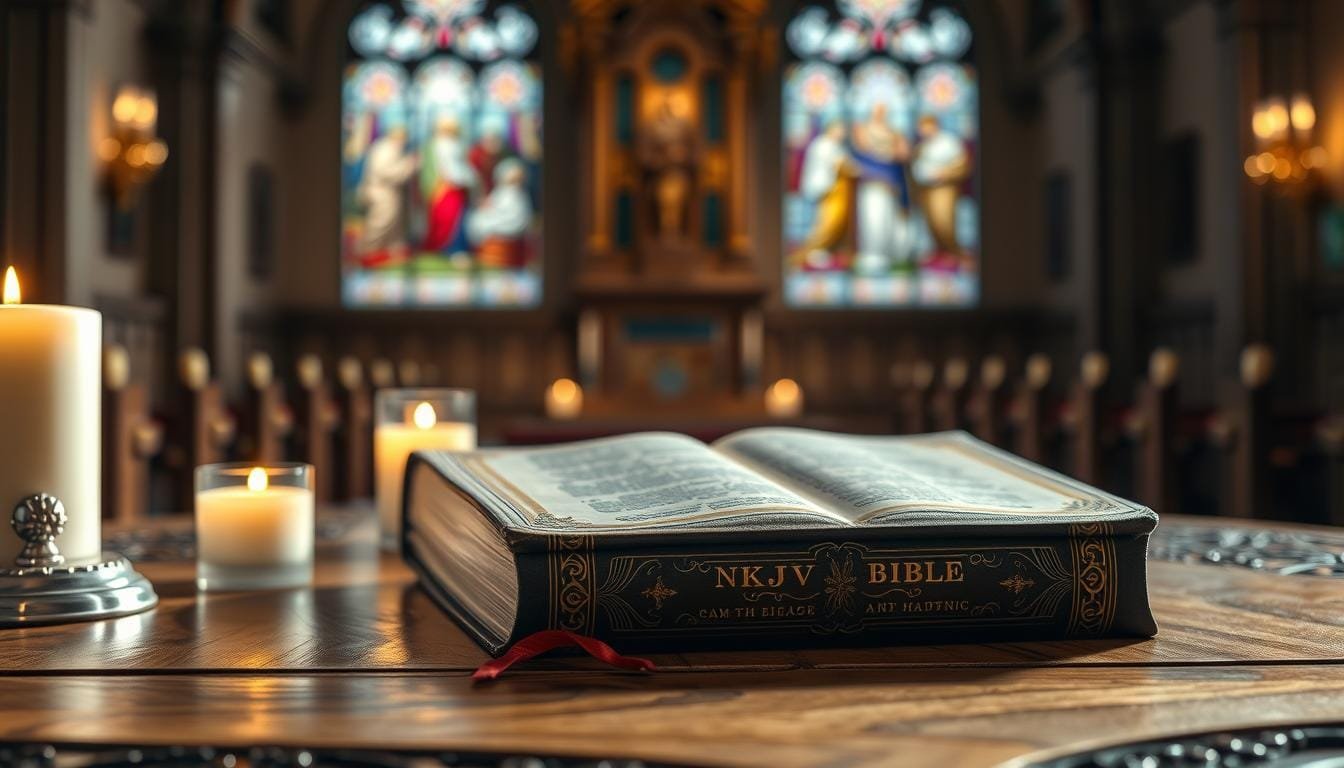Can Catholics Read the NKJV Bible? What You Need to Know
This website contains affiliate links. As an Amazon Associate, I earn from qualifying purchases. The content on this website was created with the help of AI.
Many Catholics exploring different Bible translations often encounter the New King James Version (NKJV), which has become widely read throughout the Christian world.
As traditional Catholic Bibles are well-known in the community, it’s natural to wonder: can Catholics read the NKJV Bible?
In this guide, we’ll explore the Church’s position on reading the NKJV Bible and provide you with clear guidance for your spiritual reading.
Key Takeaways
- The NKJV Bible is a popular translation used by both Protestants and Catholics.
- Catholics have a distinct approach to Bible translations, considering factors like canon and doctrine.
- The Catholic Church has its own approved Bible translations, such as the New American Bible (NAB) and the New Revised Standard Version (NRSV).
- The NKJV Bible, from a Catholic perspective, may have limitations due to its Protestant origins.
- Understanding the differences between Catholic and Protestant Bible translations is essential for informed decision-making.
- Catholics can benefit from exploring various Bible translations, including the NKJV Bible while considering the Catholic perspective.
Understanding the New King James Version (NKJV)
The NKJV Bible was first published in 1982. It is a new version of the King James Version (KJV). We will explore its history and how it translates to the Bible.
This method aims to keep the original texts’ meaning as close as possible.
The history of translation is key to understanding the NKJV Bible. The KJV, its base, has 39 Old Testament and 27 New Testament books.
The NKJV keeps this structure, offering a faithful Bible translation.
Key Features of the NKJV Bible
The NKJV Bible stands out for its formal equivalence translation. It’s also known for its accuracy and clear language.
This makes it a favorite among many Bible readers. Its history of translation is interesting, as it’s a modern update of the 1611 KJV.
History of the NKJV Translation
The NKJV Bible’s history of translation starts with the KJV. The KJV was published in 1611 and has seen many updates. The NKJV, released in 1982, offers a fresh and precise Bible translation.
The Catholic Church’s Stance on Bible Translations
The Catholic Church has always worked to translate the Bible into many languages. This effort aims to make the scriptures available to everyone.
We see the Bible as God’s inspired word and strive to translate it faithfully.
The Church values Bible translation for sharing God’s love and salvation worldwide. It’s crucial for reaching people of all languages and cultures.
Looking into the Catholic Church’s view on Bible translations, we see approved translations like the New American Bible (NAB) and the Revised Standard Version (RSV).
The Church lets people choose their preferred translation, focusing on personal preference over strict rules.
Catholic Bible translations stand out for including books like Tobit and Judith, missing in Protestant versions like the New King James Version (NKJV).
The Church also values using the original languages of the scriptures, like Hebrew, Greek, and Aramaic, in translation.
Here are some key points to consider when exploring Catholic Bible translations:
- The Catholic Church has a long history of translating the Bible into various languages.
- The Church recognizes the importance of Bible translation in spreading the message of God’s love and salvation.
- Catholic Bible translations include the Deuterocanonical books, which are not found in Protestant translations.
Understanding the Catholic Church’s stance on Bible translation helps us see its value. It shows how crucial it is to make the scriptures available to everyone, no matter their language or culture.
Can Catholics Read the NKJV Bible?
When we ask if Catholics can read the NKJV Bible, we must look at the official guidelines from the Catholic Church.
The Church hasn’t officially approved the NKJV Bible for Catholics. But, it doesn’t mean Catholics can’t read it.
It’s important to know the limits and differences between the NKJV and Catholic Bibles.
Catholic readers might miss the Deuterocanonical books in the NKJV Bible. These books are key to the Catholic Bible.
Also, the NKJV might not match Catholic teachings in some parts.
To understand these differences, Catholics can use official guidelines from the Church, like the New American Bible or the Douay/Rheims version.
Whether Catholics can read the NKJV Bible depends on their personal situation. Knowing the differences and limits helps them decide.
The Catholic Church respects personal choices in Bible translations as long as they follow Church teachings.
| Catholic Bible Translations | Protestant Bible Translations |
|---|---|
| New American Bible | King James Version (KJV) |
| Douay/Rheims | New King James Version (NKJV) |
| Navarre Bible series | Good News (GNB) |
Comparing the NKJV with Catholic Bible Versions
We will look at the NKJV Bible and compare it with Catholic Bible versions like the New American Bible (NAB) and the Revised Standard Version (RSV).
The NKJV Bible is not the only choice for Catholics. It’s important to know the differences and similarities between these translations.
The Catholic Church recognizes 73 books as canonical, covering both the Old and New Testaments. In contrast, the NKJV Bible has 66 books.
The main difference is the NKJV Bible doesn’t include 7 deuterocanonical books found in the Catholic Bible.
Some key features of Catholic Bible versions include:
- Inclusion of deuterocanonical books, such as Tobit and Judith
- Use of dynamic equivalence for text accuracy and readability
- Traditional Catholic order of books

The NKJV Bible and Catholic Bible versions have their own unique qualities.
While the NKJV Bible is favored by Protestants, Catholic versions like the NAB and RSV are preferred by Catholics.
Knowing the differences helps Catholics choose the right Bible for their spiritual journey.
| Bible Version | Number of Books | Inclusion of Deuterocanonical Books |
|---|---|---|
| NKJV Bible | 66 | No |
| Catholic Bible | 73 | Yes |
Missing Deuterocanonical Books in the NKJV
The NKJV Bible doesn’t have the Deuterocanonical books. These books, like Tobit, Judith, and Wisdom, are key for Catholic teaching. The Catholic Church sees them as authoritative.
Not having these books in the NKJV Bible shows a big difference with Catholic Bibles. These books give us a deeper look into Jewish history and faith.
They’re crucial for understanding Catholic doctrine fully.
Understanding the Canon Differences
The Bible’s canon has been a topic of debate for centuries. The Catholic Church accepts 73 books, while Protestants accept 66. The 7 extra books for Catholics are the Deuterocanonical books.
Impact on Catholic Teaching
The Deuterocanonical books greatly influence Catholic teaching, mainly in prayer and devotion. Tobit and Judith teach the value of prayer and fasting.
Wisdom gives us insights into God and the universe.
Here are some key points to consider:
- The Deuterocanonical books are a core part of the Catholic canon.
- The NKJV Bible leaves out these books, which can make understanding Catholic doctrine harder.
- These books offer deep insights into Jewish history and faith.
In conclusion, the absence of Deuterocanonical books in the NKJV Bible is a big issue for Catholics.
They are vital for Catholic teaching and doctrine. By grasping the canon differences and the impact of these books, Catholics can grow their faith and appreciate Catholic tradition more.
| Book | Content |
|---|---|
| Tobit | Guidance on prayer and fasting |
| Judith | Example of faith and devotion |
| Wisdom | Insights into the nature of God and the universe |
How to Use the NKJV as a Catholic Reader
Using the NKJV Bible as a Catholic reader needs some thought. The NKJV Bible is well-liked but lacks the Deuterocanonical books that Catholics accept.
To fill this gap, you might want to use a Catholic study Bible or look at Catholic commentaries.
Here are some tips for using the NKJV Bible as a Catholic reader:
- Know that the NKJV Bible doesn’t have the Deuterocanonical books. Look for other translations that do.
- Use Catholic commentaries to understand the Scripture better.
- Get a Catholic study Bible for context and guidance.

The main thing is to know the NKJV Bible’s limits. Then, use other Catholic resources to deepen your understanding. This way, you can better connect with the Scripture and your faith.
| Translation | Inclusion of Deuterocanonical Books |
|---|---|
| NKJV Bible | No |
| New American Bible | Yes |
Protestant Elements in the NKJV Translation
The New King James Version (NKJV) is a Protestant Bible translation. It may have elements not in line with Catholic teachings.
The NKJV is at the literal end of translations, which can cause interpretation differences.
For example, the translation of “ergon” and its forms can differ between Protestant and Catholic versions.
Some Protestant elements in the NKJV include using “Servant” in Acts 3:26, unlike the King James Version (KJV) which uses “Son”.
The NKJV also removes “thee” and “thou” from many places, changing the text’s feel. It keeps words like “Hades” and “Sheol” untranslated, unlike the KJV which translates them to “hell”.
Understanding the NKJV’s Protestant elements is key when comparing it to Catholic doctrine.
The NKJV’s literal style can sometimes clash with Catholic teachings. For instance, it translates Romans 4:2 with “works”, supporting Protestant views.
Yet, it uses different terms for “erg–” derivatives in Romans 2:6-7. This inconsistency could make God’s judgment based on “works” unclear.
Translation Choices and Catholic Doctrine
To grasp the Protestant elements in the NKJV, let’s look at translation differences:
- The NKJV sticks closely to the original language and meaning.
- Translations like the New International Version (NIV) choose words to better convey meaning.
- Catholic versions, like the Douay-Rheims, aim to align with Catholic teachings and tradition.
Navigating Theological Differences
Exploring the NKJV’s Protestant elements highlights the need to understand Catholic doctrine.
Recognizing these differences helps us see the value of various Bible translations. It also shows the importance of careful interpretation when reading Scripture.
Supplementing NKJV Reading with Catholic Resources
When we explore Scripture study, adding Catholic resources to our NKJV Bible reading is key. This helps us understand the Bible better.
We can use Catholic study materials and commentaries for a deeper look into Catholic teachings.
Some top study materials include:
- Catholic commentaries, like the Navarre Bible or the Catholic Commentary on Sacred Scripture
- Study guides, such as the Catholic Study Bible or the Ignatius Study Bible
- Online resources, such as the Augustine Institute or Catholic Scripture Study
Using these Catholic resources in our study can deepen our Bible understanding. The Augustine Institute, for instance, has released the Gospel of Matthew.
They also plan to release the Gospel of Mark, both in the Catholic Standard Version (CSV) translation.
The aim of studying Scripture is to better understand God’s word and live by its teachings.
By adding Catholic resources to our NKJV reading, we get a richer, more meaningful Bible study experience.
| Resource | Description |
|---|---|
| Navarre Bible | A Catholic commentary on the Bible |
| Catholic Study Bible | A study guide for the Catholic Bible |
| Augustine Institute | An online resource for Catholic Scripture study |
Benefits of Multiple Bible Translations in Catholic Study
Using many Bible translations is key in Catholic study. With over 500 English translations, we can better understand the Bible. By comparing them, we get a deeper insight into Scripture.
Popular Catholic Bibles include the New American Bible (NAB), the Revised Standard Version Catholic Edition (RSVCE), and the New Jerusalem Bible (NJB).
Each offers unique insights. Using several, we see where they agree or disagree, enhancing our understanding.
Choosing multiple translations helps us find the most accurate passages. For instance, the RSVCE sticks closely to the original text.
The NJB, on the other hand, aims to convey the original meaning in today’s language.
By using various Bible translations, our understanding of the Bible grows. This method helps us see the scriptures in a more nuanced way.
It also helps us apply their teachings to our everyday lives.
| Translation | Method | Description |
|---|---|---|
| RSVCE | Formal Equivalence | Emphasizes accuracy to original text structure |
| NJB | Dynamic Equivalence | Conveys original meaning in modern vernacular |
Making an Informed Decision About Using the NKJV Bible
As Catholics, we aim to make wise choices for our spiritual growth. There are many Bible translations out there, with over 60 on Bible Gateway.
The New King James Version (NKJV) Bible, released in 1982, is popular among both Catholics and non-Catholics.
When deciding on the NKJV Bible, it’s key to look at its history, features, and reading level. It was translated by 130 scholars and has a reading level of 9.
This makes it a medium-level translation. For comparison, the NIV has a level of 7, and the ESV is at 10.
When evaluating the NKJV Bible, consider a few things:
- How accurate is the translation to the original text?
- Is the reading level clear and easy to understand?
- Does it include deuterocanonical books and other Catholic traditions?
- Are there good commentary and study resources available?
By thinking about these points, we can decide if the NKJV Bible fits our spiritual path. We can also use Catholic resources, like The Catholic Daily Prayer Book, to deepen our faith.
In the end, choosing the NKJV Bible or another translation depends on our personal needs and preferences.
By being informed and discerning, we can pick a Bible that aids our faith growth and strengthens our bond with God.
Conclusion
The New King James Version (NKJV) Bible is popular among both Protestant and Catholic readers.
It keeps the traditional feel of the original King James Version (KJV) but makes it easier to read today. This makes it a great choice for many.
Catholic readers can find the NKJV helpful as a secondary resource. It’s known and easy to understand.
But it’s missing some books that Catholics consider important. So, it’s best to use it with a Catholic-approved Bible for the full story.
We suggest Catholic readers use the NKJV with caution. Pair it with trusted Catholic sources and study guides.
This way, they can deepen their understanding of the Bible while staying true to their faith.


















